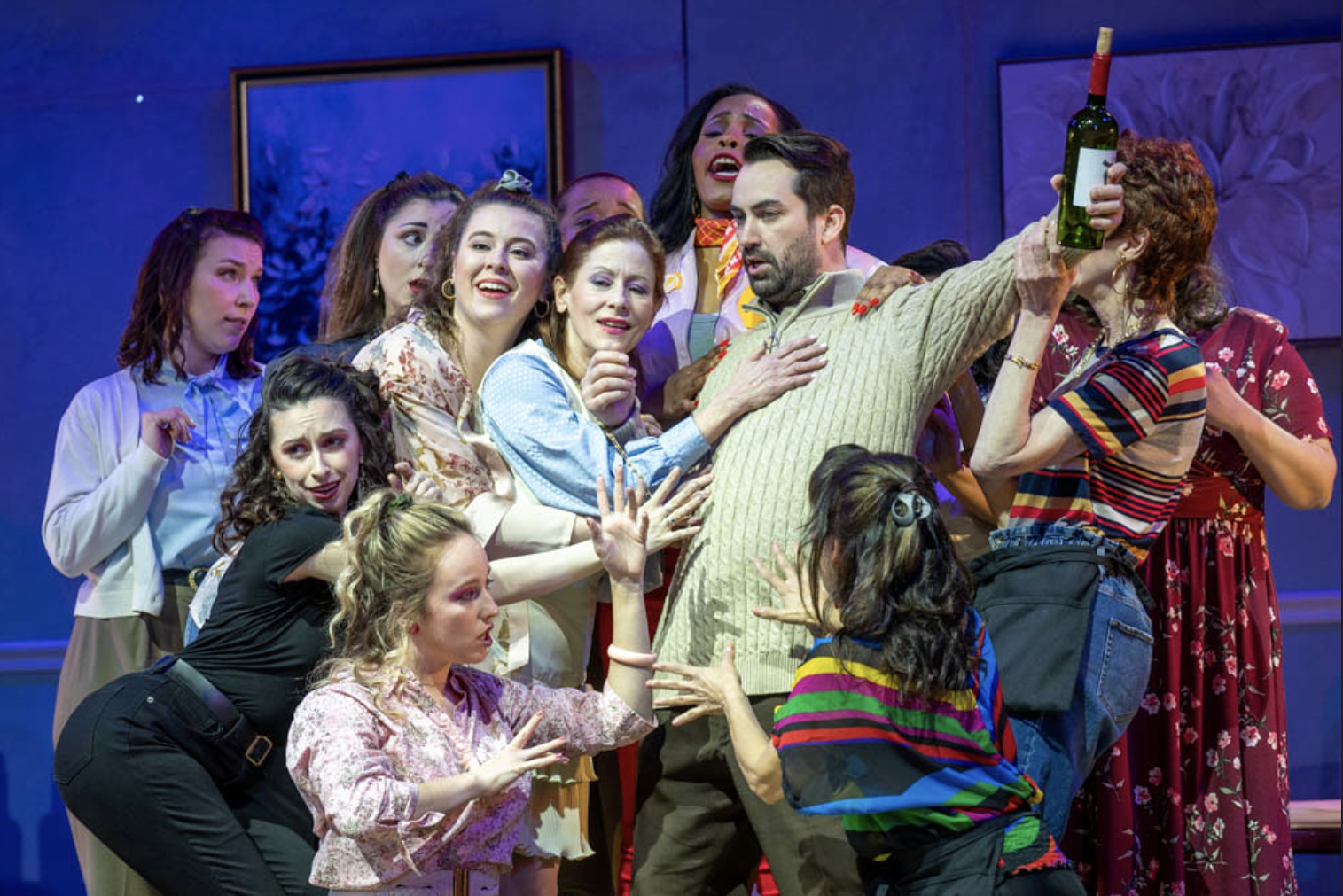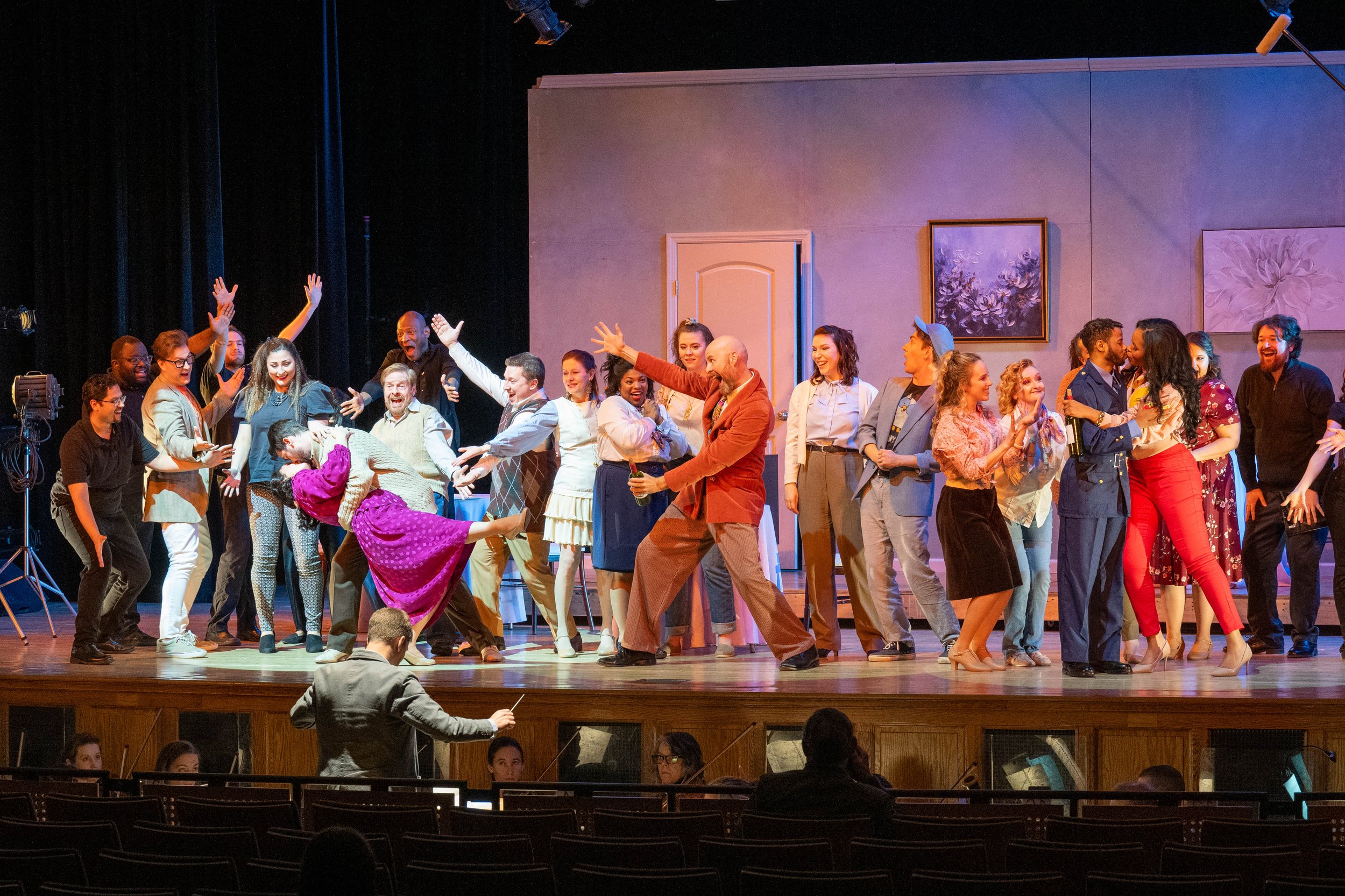No one expected Casablanca to become the hit movie it became, but the combination of characters and their players in a love story shrouded by the backdrop of Nazi occupation during WWII achieved perfection: it hit all the right notes and touched our hearts. I think a parallel can be drawn with composer Gaetano Donizetti and librettist Felice Romani’s bel canto opera L’elisir d’amore (The Elixir of Love, 1832); a simple love story moving forward with comic mishaps propelled by gorgeous music and arias that touched the hearts of the first audiences to hear it; it became an instant hit and classic, still popular today. Elixir has a special place in my heart, as does Casablanca, which I have seen more times than I will reveal; L’elisir d’amore was the opera that caused me to fall in love with opera. Annapolis Opera’s updating of the story certainly bears comment but proved to be colorful and fun, colorful costumes and singing, an arresting set design, and an attractive group of talented players. Read on.
Nemorino (Brian Wallin) hugs Dulcamara (Timothy Mix) who has provided him with a love potion. Photo by Michael Halbig; courtesy of Annapolis Opera.
Romani’s libretto is adapted from a French opera that premiered the prior year, La Philtre, by composer Daniel Auber and librettist Eugène Scribe. Nicole Steinberg who gave the Annapolis Opera pre-opera talk stated that Donizetti and Romani, the A-team in Italy at the time, wanted to infuse more human poignancy into the story; it worked, and while La Philtre was also a success, it’s telling of the story eventually faded into history while Donizetti’s maintained its status in the opera repertoire. This is a showcase opera for the music and a soprano, but it really is the tenor’s opera; yet, Elixir contains beautiful arias for all the principal players to display their talents, as well as a major role for the chorus.
Dulcamara (Timothy Mix) and Adina (Véronique Filloux) film a commercial. Photo by David Herron; courtesy of Annapolis Opera.
In the classic plotline, the scene is a country village in Spain where a simple, poor man Nemorino, played by a tenor, has fallen in love with the wealthy landowner Adina, played by a soprano, who is pursued by the military sergeant Belcore, played by a baritone. In AO’s production, Nemorino works as a cameraman for a 1980s television sitcom, where the star is Adina and her co-star is Belcore. Nemorino has fallen desperately in love with Adina but is too shy to approach her and tell her of his feelings. She has feelings for him, but it takes a while for her to become fully aware of how strong they are. Belcore, her on screen and off screen partner, is an arrogant, belligerent young man who finds himself irresistible and believes that Adina will marry him. Yet, she is hesitating, and we know why even if she doesn’t. Nemorino hears Adina telling the story of Tristan and Isolde, recounting how Tristan used a love potion to capture Isolde’s heart. It so happened a caterer, the shyster Dulcamara, is in the studio who claims to have a potion able to cure whatever ails you. Nemorino approaches Dulcamara seeking a love potion, and of course Dulcamara obliges with such a potion (a bottle of cheap Bordeaux) for the price of what money Nemorino has in his pocket. Meanwhile, Adina plays Belcore against Nemorino to get our hero to express his true feelings, while Belcore tries to move Nemorino to a new location. I will reveal no more of the plot since I thinks it’s more fun on a first viewing to witness how the plot unfolds, but you can see how things are set up for some outrageous comedy before arriving at a happy ending.
center left to right: Nemorino (Brian Wallin), Adina (Véronique Filloux), and Belcore (Kyle Oliver) surrounded by the AO Chorus. Photo by Robert Young; courtesy of Annapolis Opera
Donizetti’s pleasurable music was well played by the 26-member Annapolis Symphony Orchestra under the direction of Maestro Craig Kier, who also serves as AO’s Artistic Director. Maestro Kier maintained the strong support of the action on stage by the orchestra, providing well-timed pauses to let the audience express its appreciation for the singers’ performances. While mainly the strings carried the beautiful melodies, I really like the ornamentation and interplay provided by Kimberly Valerio on flute, Emily Madsen on oboe, and Robert Delutis on clarinet, and the harp was played beautifully by Madeline Jarzembak for the opera’s most popular aria “una furtivo lagrima”.
All the principal singers were a delight in this production. Tenor Brian Wallin, an AO veteran, played Nemorino. He seemed to walk through his role early on, but his comedic talents came out once he began pursuit of the love potion; I began to like this shy young fellow. His vocals were generally excellent, and his singing of “una furtiva lagrima” neared perfection; he received the most vigorous and sustained applause of the performance. Adina was played by French-American soprano Véronique Filloux, whom I’ve had the pleasure of hearing in performances locally as well as in the lead role of Pittsburgh Opera’s Semele. As Adina, her coloratura virtuosity was impressive, soaring easily from mid-range to high notes on several occasions; she also provided clearly distinguished high note accents in ensemble pieces, but it is when she sings the gentlest pieces that the beauty of her voice can be best appreciated. She was a believable actress as Adina, a young woman coming to terms with hidden feelings. Yet somehow, for me despite the excellent individual performances, the chemistry of attraction between these two never quite developed convincingly, certainly not like that betweeen Rick and Ilsa.
The girls on the set (the AO women’s chorus) chase after Nemorino (Brian Wallin) whose fortune has changed. Photo by Michael Halbig'; courtesy of Annapolis Opera.
The performance of baritone Kyle Oliver as Belacore was a special treat early on as he portrayed comically the narcissistic co-star and love interest of Adina. His threats of physical violence were less convincing. His smooth singing with a lovely baritone timbre might have won over Adina if he could have gotten over himself. Baritone Timothy Mix who played Dulcamara, is a fine singer and a terrific comedian; his antics were the comedic highlight of this performance. His duet with Adina, once she realized her true feelings for Nemorino, was also a highlight.
One character not mentioned above is Giannetta, Adina’s friend in the classic version, but here more of a competitive understudy grabbing her chances in the spotlight. Played by soprano Denique Isaac, she was eye catching on stage, and gave us a measure of her impressive singing as she informed the girls of a recent change in Nemorino’s fortunes. The 22-member chorus also served as supernumeraries, appearing in costume on stage. They sang beautifully and powerfully, at times perhaps a little too powerfully. The ensemble piece with Giannetta and the women members of the chorus as stagehands on the set was a special delight. Kudos to Chorus Master JoAnn Kulesza.
The happy ending with a closing ensemble with Nemorinao (Brian Wallin) kissing Adina (Véronique Filloux) as Dulcamara (Timothy Mix) celebrates the success of his elixir and Belcore and Gianetta are smooching. Photo by Michael Halbig'; courtesy of Annapolis Opera.
Director Ben Robinson developed this version of Elixir for Anchorage Opera’s production. In his message in the program notes, he stated that in adapting a classic opera to a new setting, he “wants to account for every musical nuance that the composer infuses into the piece.” I believe in that he was largely successful. Still, the updating was a two-edged sword. The plot line required a greater suspension of disbelief than the classic versioin, difficult to believe that a reserved television cameraman would be unable to come up with twenty bucks and moving to a nearby set carries less weight than being conscripted to go into the military. The set presenting a television sound stage with lights, cameras, and action worked convincingly; kudos to Scenic Designer Rochele Mac. Overall, it was a familiar setup for modern viewers raised on television. The overhead screen showing what a TV audience would be seeing added interest but was also a distraction. The building tension between the two would-be lovers needed focus and time to simmer to also bring the audience more deeply into the love story. I thought the pace supported the comedic aspects over the love story. The colorful costumes were fun and accented the light-heartedness of the opera; kudos to Costume Designer Kathryn Braden. The action was well-orchestrated by Director Robinson.
Overall, I enjoyed the performance; it was colorful and fun, and I liked being able to view the story through a different lens. The music and the singing were wonderful. At the same time, I felt the nostalgia for the 80’s television had been substituted for the simple charm of the classic staging. It was great entertainment, but for me, the human poignancy got a little bit overshadowed in the shuffle and the love story less compelling. Also, I felt that Felice Romani’s dialog had been altered to the point that perhaps this version should be given a new name, maybe “Nemorino Loves Adina”, adapted from The Elixir of Love. Perhaps it would have worked better for me if I had not seen the classic version first. Nonetheless, it was an enjoyable afternoon, and Annapolis Opera continues to play above its weight in presenting fine arts entertainment to its community.
The Fan Experience: Performances of The Elixir of Love were scheduled for March 15 and 17 in the Maryland Hall for the Creative Arts . The opera was sung in Italian with supertitles in English shown on a screen over the stage; the performance ran about two and half hours, including one intermission. Parking at the Maryland Hall was free.
This was the last staged production of the season for Annapolis Opera, but two more events are scheduled:
April 14 – Voices of Our Time: Vocal Competition All Stars; tickets at this link.
May 5 – 36th Annual Annapolis Opera Vocal Competition; this is a free event. I personally recommend this one, some of the best singing you will hear and at a price that can’t be beat. You also get to vote on your favorites.





